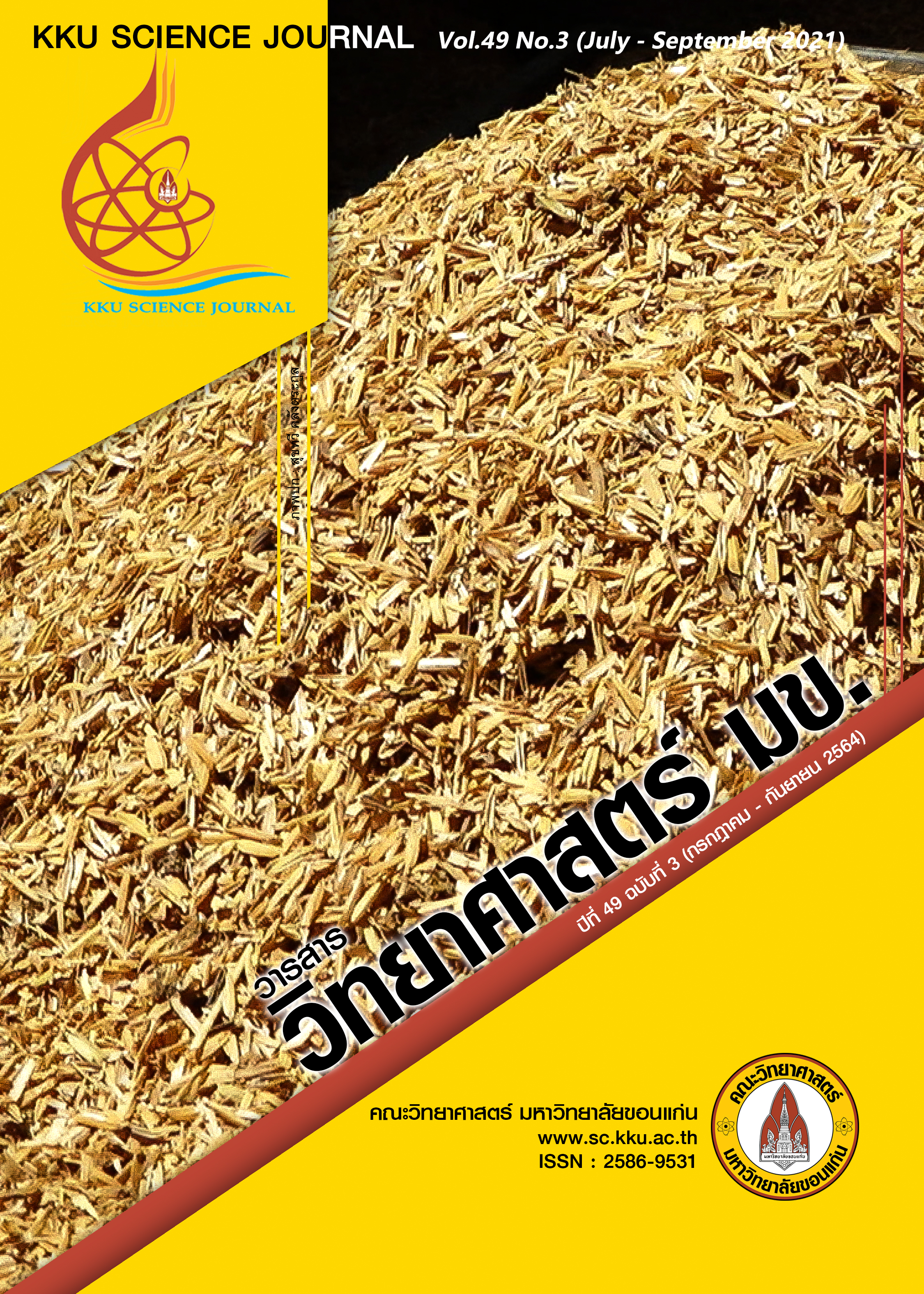Development of Healthy Seasoning Pork Rind Product
Main Article Content
Abstract
Pork rind is a popular dish eaten in Thailand which is produced by frying pork skin to make it crispy and then seasoning. Fried food contains reused oil causing diseases such as heart disease, high blood pressure, vascular disease, etc. This research is to develop oil-free flavored pork rind product using a hot air oven with 6 temperature variations starting from 160 °C to 210 °C. Roasted pork rind was analyzed for the texture characteristics in terms of hardness, brittleness, crispness and sensory quality evaluation by the 9-Point hedonic scale which 60 assessors were used. It was found that at 200 °C for 15 minutes, the texture was blistered and crispy and the pork rind had the highest overall preference score. When comparing the sensory characteristics of roasted pork rind and seasoned fried pork rind for all 4 recipes. It was found that roasted pork rinds and seasoned fried pork rind in formula no. 4 had a taste preference score, the overall taste and preference score were highest. The preference scores on appearance, color and crispness were not significantly different from other formulations (p>0.05). For the product development of fried pork rind and seasoned roasted pork rind, it was found that in comparing the nutritional value roasted pork rind had higher protein content than fried pork rind by 23.21% and had less fat content than fried pork rind by 31.44%. Resulting in the total energy and the fat energy of roasted pork rind was less than that of fried pork rind by 7.73% and 31.44%, respectively. The roasted pork rind and fried pork rind product were stored in aluminum foil bags for 12 weeks at room temperature and undergo sensory testing. It was also accepted by eight sensory assessors. Roasted pork rind is a healthy product that can be substituted for fried pork rind product.
Article Details

This work is licensed under a Creative Commons Attribution-NonCommercial-NoDerivatives 4.0 International License.
References
ธเนศ แก้วกําเนิด. (2534). การปรับปรุงกรรมวิธีผลิตและอายุการเก็บของแคบหมู. วิทยานิพนธ์วิทยาสตรมหาบัณฑิต, จุฬาลงกรณ์มหาวิทยาลัย. กรุงเทพฯ: 115 หน้า.
ธันยบูรณ์ อรัญนารถ, ปทุม อรุณวัชรินทร์, พิมพร วงษ์สุทธิโชติ, จิดาภา อาจารยะศิริ, สงวนศรี เจริญเหรียญ และรสพร เจียมจริยธรรม. (2559). การพัฒนาแคบหมูลดนํ้ามันโดยการทอดด้วยเตาอบไมโครเวฟ. วารสารวิทยาศาสตร์ มศว. 32(1): 167-177.
บัว เดชอนงค์, นิรมล ภิลาลัย, โรจนศักดิ์ คลังวิเชียร, วันทนา สวนเศรษฐ, ผกาวดี ภู่จันทร์ และโสรัจ วรชุม อินเกต. (2560). การพัฒนาผลิตภัณฑ์แคบหมูเสริมผงขมิ้น. ใน: รายงานสืบเนื่องจากการประชุมวิชาการระดับชาติ ครั้งที่ 4 สถาบันวิจัย มหาวิทยาลัยราชภัฎกําแพงเพชร. กําแพงเพชร: 1147-1155.
ไพโรจน์ วิริยจารี. (2545). การประเมินทางประสาทสัมผัส. เชียงใหม่: คณะอุตสาหกรรมเกษตร มหาวิทยาลัยเชียงใหม่. หน้า 1-574.
ไพโรจน์ วิริยจารี. (2555). การออกแบบการทดลอง (experimental design). เชียงใหม่ : คณะอุตสาหกรรมเกษตรมหาวิทยาลัยเชียงใหม่. หน้า 1-437.
ศนันธร พิชัย. (2562). การพัฒนาผลิตภัณฑ์แคบหมูไมโครเวฟ. วารสารเกษตรพระวรุณ 16(1): 165-173.
AOAC. (2016). Official Methods of Analysis. 20th ed., The Association of Official Analytical Chemists. Maryland, U.S.A.
AOAC. (1993). Methods of Analysis for Nutrition Labeling. Darryl M. Sullivan and Donald E. Carpenter ed. p. 8 and 106.
Truong, K. T.- P., Le, T. Q., Songsermpong, S. and Le, T. T. (2014). Comparison between traditional deep- oil and microwave puffing for physical and eating qualities of puffed pork rind.Kasetsart Journal: Natural Science 48(5): 799-814.


